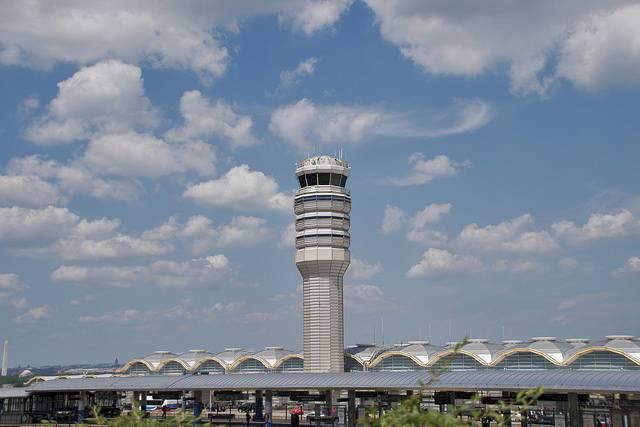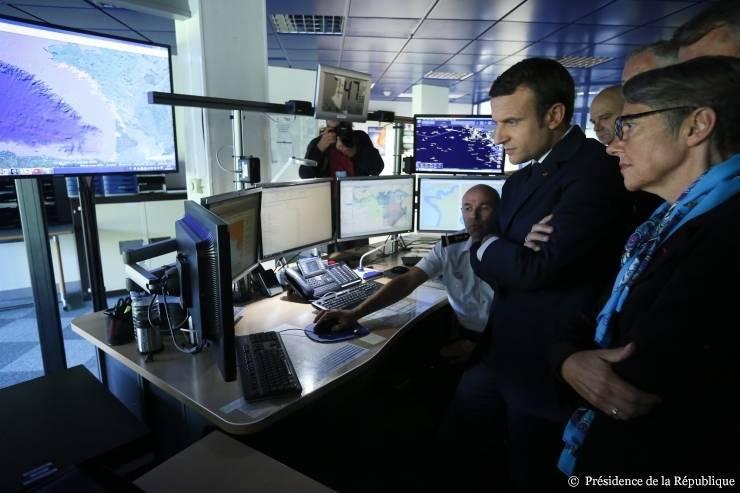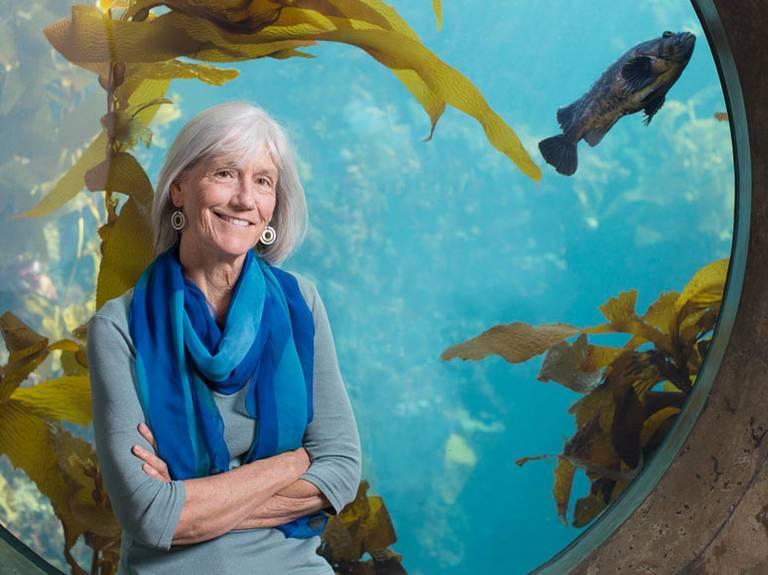Trump’s FAA Privatization Plan Could Reduce GHG Emissions


He may be backing out of the Paris Agreement, but if there is any silver lining in Donald Trump’s environmental policies, it is up in the sky: his plan to privatize the Federal Aviation Administration (FAA) could actually reduce the greenhouse gas emissions in the long run, albeit slightly. There are a few problems with the plan, however, including the fact the White House has not mentioned the potential environmental benefits.
Air travel is one transportation sector that is expected to change, or “transform,” very little in the coming years, and it is also expected to keep expanding as more passengers hit the skies. But with that growth come greater emissions, and there is little evidence that the sector will be able to improve on that metric. Many airlines have tinkered with biofuels in attempting to reduce their carbon footprint, but the problem has always been scalability. Therefore, if the current infrastructure governing American commercial aviation could become more efficient, emissions could actually decrease.
Trump’s plan, which includes a complete reorganization of air traffic control systems across the U.S., could accomplish exactly that. The FAA would be replaced with a “non-governmental entity,” though in reality it would be what is often described as a government sponsored enterprise (GSE) such as Fannie Mae, Sallie Mae or the Farm Credit System. The logic follows that no longer encumbered by government bureaucracy and kindred turf wars, a new aviation governing authority would reduce delays, allow planes to fly closer together and result in shorter and more direct flights requiring less fuel. The transition from the outdated radar-based system to one reliant on GPS, which supporters say would help make the sector far more efficient, would also occur at a faster pace.
Such changes are supposedly underway with the FAA’s “NextGen” modernization agenda, but the initiative is reportedly bogged down in bureaucratic delays, depending on the source cited. Airlines, which are enjoying record profits after decades of boom and bust cycles, are also part of the problem, as they see no incentive to change the system from how it currently operates, according to Michael Boyd on Forbes.
Whether this transformation of the FAA can become the reality presents a ‘yuge’ question mark. As with any bold agenda, it needs to be sold, and the current “negotiator-in-chief” has so far had a hard time selling the public and a recalcitrant Congress on many of his ideas. Furthermore, some influential congressional members of both political parties will be reluctant to let go of any oversight of the FAA. Selling his plan's potential climate benefits could actually help the proposal gain steam, as polls have indicated that a majority of Americans, as well as the business community, supported the idea of the U.S. remaining in the Paris Agreement. But Trump, whose rhetoric has long insisted that jobs and the environment are mutually exclusive, will not budge as he needs to maintain support amongst his base.
In addition there are also the stubborn questions related to costs. Currently the FAA charges a 7.5 percent excise fee on tickets; that would be eliminated if a privately-run organization takes its place. But that does not guarantee that prices would drop. The experience of consumers in other countries, such as Canada and the United Kingdom, showed that air ticket prices actually spiked as high as 59 percent. Airlines could simply impose their own fees, including the ones that are currently tucked into the cost of ticket prices. “Air travelers could be in for a bumpy ride,” concluded Jacob Passy on MarketWatch.
Writing for Vox, Alexia Fernández Campbell also suggested that airlines could impose additional fees that could make air travel more expensive for consumers. Under pressure to pay for the cost of modernizing the nation’s air traffic control system, airlines would have to find a way to cover their costs. You can bet that airlines will not front those costs – passengers will, and then some.
Image credit: Ron Gogswell/Flickr
21 Percent of Palm Oil Now Responsibly Sourced


According to the Roundtable on Sustainable Palm Oil (RSPO), almost 12 million tons, or 21 percent of the global supply of palm oil, is now certified as responsible and sustainable. According to SCS Global Services, a certification and auditing firm, several factors are behind the growth of sustainably sourced palm oil, including increased consumer demand and government regulations. Earlier this spring, for example, the European Union suggested a ban on the imports of palm oil for biofuel. In addition, more food companies are committing to ending deforestation within their supply chains, which helps drive up demand for RSPO-certified palm oil.
“We're really pleased to see RSPO certified sustainable palm oil achieve more than 1/5th of the market,” said an RSPO spokesperson in an emailed statement to TriplePundit. “We also know that we have a lot of work to do to transform the palm oil market to make sustainable palm oil the norm, and we know we must set and implement a standard that is credible and leverages on global markets, and at the same, leaves no one behind.”
According to Darrel Webber, the CEO of RSPO, improvements in the monitoring and auditing of palm oil operations have also helped the organization’s cause. Grievances related to working conditions and human rights are also being handled more quickly. The organization has also found more success in partnering with governments to help shape policies that improve environmental protection while assuring companies that their sustainable supply chains are, indeed, more responsible and sustainable.
Meanwhile, pressure from NGOs on companies reliant on palm oil is also making a difference. Some of the activism is sabre rattling, as in the case of NGOs demanding that food and beverage firms such as PepsiCo take a stronger stand against deforestation. But leveraging the power of investors also appears to be making a difference.
Mighty Earth, for example, is one organization that has highlighted the role that financial institutions have in providing capital that make the expansion of palm oil plantations, and therefore deforestation, both possible in the first place. Greenpeace has also spoken out against the billions of dollars banks have loaned to companies that have been accused of accelerating deforestation in countries such as Indonesia. To that end, BNP Paribas, by most accounts the world’s seventh largest bank, has announced that responsible palm oil production is a precondition to secure financing in order to protect both forests and local communities that depend on them spiritually and financially.
Other companies are also hearing the message loud and clear, and replying in kind. Olam is one company that has attracted its share of scrutiny as it has expanded its operations to countries in Africa, including Gabon. The Singapore-based commodities giant recently announced that at least 100,000 landowners are now registered within a proprietary system accessible with a smartphone app. This platform collects and applies data that improves supply chain traceability while offering palm oil farmers advice and allows for them to collect payments via mobile telephones. “This gives the farmers, Olam and our customers greater insight to tackle issues from poor yields to climate change and child labor,” explained an Olam spokesperson in an email exchange with 3p, “and by geotagging each bag of produce we can trace it from farm to fork, providing assurance to end users on product provenance.”
Watch for environmental groups to keep the pressure on these companies, which can only benefit RSPO in the near future. The orangutan has been the enduring symbol of the global palm oil industry’s impact on the environment, with WWF and others saying this animal is close to extinction. Progress is being made, but there is still plenty of room - as in the 79 percent of palm oil that is not yet certified - for improvement. This endangered animal has proven to serve an effective emotional tool to push the industry to change its ways – and for its long-term viability, palm oil companies have no choice but to show consumers they can be trusted.
Image credit: Lian Pin Koh/Flickr
We’ll Always Have Paris: Why U.S. Withdrawal from the Agreement Won’t Stop Us from Meeting Its Goals


By Matt Tomich
By deciding to withdraw from the Paris climate agreement, President Trump has ceded U.S. climate leadership on the global stage. The U.S. will be joining Syria as the world’s only refuseniks. The other non-signatory is Nicaragua, which didn’t sign the agreement because it didn’t go far enough.
The EU and China are stepping into the vacuum the U.S. leaves, asserting their climate leadership and spelling out exactly how they plan to meet their targets under Paris. With the U.S. pulling out, 21 percent of total emissions reductions the Paris agreement envisioned will have to come from somewhere else. China and Europe will need to play even bigger roles than they planned, and everyone else will have to step up their reductions targets.
But we need not give up hope for U.S. climate action, because American grassroots groups, environmental organizations, municipalities, individual states and business leaders can carry the ball. With or without a treaty or federal mandate, they can get the U.S. to the Paris goal of reducing greenhouse gas (GHG) emissions 80 percent below 2005 levels by 2050.
To put things in perspective, this was always going to be volunteer work, treaty or no treaty. The Paris agreement is a framework for voluntary action toward an aspirational goal and for reporting on progress. The burden of implementation was always on the coalition of the willing: states, cities, companies and citizens who understand the importance of acting to protect the climate.
Backing out of Paris is shameful, but doesn’t stop the willing from acting – on the contrary. California, Colorado, Washington and other states are committed to ambitious GHG reduction. Cities from Los Angeles to New York have climate action plans that meet or exceed Paris goals.
But to implement them, we will have to address not just smokestack sectors like energy (electricity generation) and industry, but also the transportation, building, waste, and land use (including agriculture and forestry) sectors, which have surprisingly large climate footprints. Few realize that the single largest source of U.S. emissions is not energy or industry; it’s transportation, which accounts for 25 percent of our GHG emissions. Transportation is also our single biggest opportunity, because practical solutions can transform its emissions today.
There’s visible progress for light vehicles: recharging stations, improving batteries and diversifying electric cars. But the heavy transport sector including 10 million buses and trucks, has been harder to decarbonize, because it requires higher energy density than batteries or most renewable fuels have.
But now there’s a renewable fuel that can power it: “biomethane” or “Renewable Natural Gas” (RNG). It’s made by capturing methane gases generated from decomposing organic wastes -- food and yard waste, manure, landfill gas and municipal wastewater. RNG is the lowest-carbon fuel available today, and its feedstocks are abundant everywhere. Compared to diesel, RNG can reduce GHG emissions up to 120 percent.
How can that be? RNG captures methane gases which would otherwise escape into the atmosphere, as organic wastes rot, and harnesses them as fuel. That can save more emissions than the fuel produces when burned in vehicles. Put another way, RNG is a carbon-negative transportation fuel; making and using it results in a net GHG reduction that actually improves the climate.
The Paris climate talks in 2015 were abuzz with futuristic speculation about high-tech carbon-negative energy strategies we might be able to invest in and develop in coming decades. Delegates realized such strategies would be needed to meet the emissions reductions goals. But RNG is the one carbon-negative strategy that exists now, and is already scaling up.
Almost 50 plants produce it, and 20,000 refuse trucks run on it. The entire Los Angeles transit bus fleet plans to switch to it entirely. Using proven commercial technology, enough RNG can be produced to displace more than a quarter of the diesel heavy-duty vehicles consume. Bus and truck fleets that convert to RNG will quickly meet and exceed the Paris goal of 80 percent emissions reduction compared to diesel. Other benefits include modest fuel prices, quieter engines, and cleaner air for millions of Americans.
The climate imperative is scientific, environmental, social and economic. Political ups and downs don’t alter it. The good news is, whatever the federal government does or doesn’t do, there are practical solutions like RNG to help us meet and even exceed our highest emissions reduction ambitions. In that sense, we’ll always have Paris.
Matt Tomich is President of the non-profit organization Energy Vision, whose mission is to research and promote viable technologies and strategies for a sustainable, low-carbon energy and transportation future.
Image credit: Kristain Baty, Flickr
Diplomatic Backlash Against Qatar Imperils Workers, Sustainable Development


Relations between Qatar and its neighbors along the Gulf have been fraught for years. The tiny oil kingdom and the United Arab Emirates, for example, have been uneasy neighbors since Qatar declined to join the UAE in the early 1970s, instead deciding to go at independence alone. Nevertheless, the decision by several Arab nations to sever diplomatic ties over allegations of Qatar’s ties to terrorism with this country of 2.5 million people has roiled diplomatic channels as well as the equities markets.
And while many analysts are speculating about the ongoing power play between forces such as Iran, Saudi Arabia and the U.S., the sudden isolation of Qatar will make life even more difficult for its hundreds and thousands of expatriate workers, many of whom are building glitzy new stadia for the 2020 World Cup. Food will be coming into the country at a slow trickle, if at all, and it will be difficult to leave – as well as near-impossible for human rights activists working on the sly to visit.
The rapid loss of transport links should serve as just the first lesson to governments that if they are ever going to develop long term resilience plans, the time to start that was yesterday.
Media reports have given copious amounts of coverage of how the closure of Qatar’s sole land border with Saudi Arabia has led to panic buying in supermarket chains such as Carrefour. And not only has the country’s flagship carrier, Qatar Airways, been banned from landing in nations such as Bahrain, Saudi Arabia and the UAE, the country has lost almost all of its adjacent airspace. Qatar Airways’ planes, in effect, could be grounded as long as this diplomatic crisis festers.
What no one is asking is how cutting off Qatar from most of the world will have an impact on the workers who have toiled on Qatar’s new buildings and sports infrastructure. The documentation of human rights violations piled on construction workers, most of whom are from Nepal and India, has been ongoing for several years. But as attention shined on the first state-of-the-art air conditioned stadium’s opening, organizations including Amnesty International have accused the Qatari government of looking the other way while construction companies have made little progress addressing accusations of workplace abuses.
Complaints have included steep recruitment fees, working excessive hours, fear of reporting health and safety violations and the confiscation of passports. In a nation where per capita income is around $130,000, these workers make as little as $350 a month (less than the average wage in Somalia, as BBC pointed out), and the hundreds of thousands of guest workers living in Qatar face a frightening future as few people are allowed to fly in or out. Will any of the riches that Qatar has amassed, the amount of which reportedly could allow its citizens to ride out this storm, be invested at all to shield workers from what could be several grim weeks, if not months?
One thing these poor and overworked workers share with Qatar’s wealthy nationals is they will all suffer from any lack of sustainability or long-term resilience plans. Qatar’s sustainable development plans have been at most token efforts encourage businesses to be more “sustainable” or to welcome some electric cars on its roads. Some building developments, such as Msheireb in downtown Doha, have attempted to meld green building and celebrate the country’s heritage. But the country’s tenuous supplies of fresh water and food have never been addressed, surprising considering the prickly relations it had long had with its neighbors.
In the case of food security, Qatar’s plan to simply buy and lease farmland in other countries will now exact a toll on citizens no matter how generous their bank accounts may be. Saudi Arabia, the breadbasket (and produce stand) of much of the Gulf region has closed its border with Qatar, which sources 40 percent of its food from its much larger neighbor. Iran has reportedly said it could fill that gap, but ships take about 12 hours to cross the Gulf – hardly any comfort to citizens and expatriates who have already cleaned out the country’s supermarket shelves. Qatar imports 99 percent of its food needs; its moves to invest across lands as far away as Brazil is of small consolation if those products cannot enter Qatar’s borders in the first place.
Arabs living in the Gulf have long said that oil has been both a blessing and a curse. In the case of Qatar, which by most accounts has the world’s third or fourth largest reserves of hydrocarbons, its wealth will offer few blessings as this diplomatic drama unfolds. And the country’s poorest and most vulnerable residents, who do not even enjoy the benefits of citizenship, may pay the largest price whether they are stuck, or fleeced out of what little they have in the event they are allowed to return home.
Image credit: Jan Smith/Flickr
U.S. Cities, Companies Move Forward on Climate Commitments


In case you missed it, the Trump Administration last week announced that the U.S. would leave the Paris Agreement reached during COP21 in late 2015. And if you’ve really been asleep, then you have missed all the outrage expressed by world governments, NGOs and environmental leaders.
The reality, however, is that the U.S. cannot back out of the global climate agreement until late 2019; and due to the treaty’s requirement that member states give one year’s notice, then the exit would not be completed until November 2020, the same month as the next presidential election. So if a year is a lifetime in politics, then three years is a millennium.
Indeed, the White House’s announcement presents bad optics, and will foment plenty of diplomatic tension over the next few years – but for many companies and advocacy groups here in the U.S. and abroad, it will be business as usual. In fact, Trump’s announcement may actually be the spark many organizations need to accelerate their climate action plans. “Trump may have inadvertently done us a tiny favor this week, because the problem with climate change is that it has always felt so abstract and impersonal and far off in the future,” said John Oliver recently on Last Week Tonight.
A similar outlook was expressed over the weekend by former Vice President Al Gore. Noting that the clean energy sector is creating jobs at a rapid pace, Gore told CNN’s Jake Tapper that the momentum behind the sustainability movement will be hard to stop. “We could have faster progress with presidential leadership, but we’re going to keep moving forward regardless of President Trump,” said Gore. “We are going to see continued reductions in emissions in the U.S., and we’re going to meet the commitments under the climate pact in Paris regardless of what President Trump does.”
The White House may have turned its back on climate action, but here in the U.S., plenty of governors and mayors are ready to fill in that void. Andrew Cuomo and Jerry Brown, the governors of New York and California, respectively, have confirmed that their states will commit to the Environmental Protection Agency’s Clean Power Plan, and may even exceed their targets. Mayors of at least 211 cities recently announced they will do their part to meet their voluntary climate goals – hardly a token effort as 80 percent of Americans live in urban areas. President Trump may have said he was “elected to represent the citizens of Pittsburgh, not Paris,” but Pittsburgh’s mayor, Bill Peduto, said his city is sticking to the agreement, and recently signed an executive order that maintains the city’s commitment to the Paris climate deal.
Those action plans will be complemented by the efforts of those including Mike Bloomberg, the former mayor of New York City who recently announced his philanthropic organization will contribute funds to replace money Trump Administration has withheld from implementing the Paris Agreement.
Many leaders in the private sector say they will move forward on climate action no matter what the White House does or does not do. While some CEOs who have spoken out in opposition to a U.S. exit from Paris will stay on as advisors to the White House, several, including Tesla’s Elon Musk and Disney’s Bob Iger, have cut their ties to the administration.
Trump’s decision to nix any U.S. political commitment to climate change also opens up the door to world leaders who are willing to step up and claim that they are the leader of the free, and climate resilient, world. Germany’s Chancellor Angela Merkel has vigorously defended the climate deal as “essential” since last week’s news from the White House. And France’s new President, Emmanuel Macron, whose long, extended handshake with Trump last month launched endless rounds of speculation and memes, is eager to step into the shoes vacated by the U.S. president. Macron has reportedly offered “refuge” climate scientists, offering his country as a “second homeland” as he mocked Trump, saying France will do what it can to “make the planet great again.”
With a president holding on firmly to his base but losing just about everyone else, leaders in the private sector, civil society and government have the opportunity to stand tall in the climate debate. Whether it’s a British department store or shareholders telling an oil company to be accountable, business is doing more than carrying on. Trump’s latest move could not only spark more activism, but concrete action on climate.
Image credit: Government of France
Unilever's Sustainable Food Manifesto


How do we ensure that there's enough nutritious food produced to feed the whole planet? That's a question that companies, governments and NGOs have been wrestling with for decades. Some say that it necessitates changing how we farm; others suggest that increasing social development is the key. Yet others see it as a problem of quantity.
But unlike many social and economic questions these days, there's one interesting commonality: Pretty much everyone who weighs in on this issue says it can be done.
In 2016, the World Resources Institute published a summary of what it would take to ensure that food production was not only sustainable but satisfactory for feeding the world's population in 2050. It pointed out that producing food wasn't the be-all, end-all of feeding the world's growing population. Nutritional sustenance was.
"New analysis shows that we’ll need about 70 percent more food calories in 2050 than in 2006 if global demand continues on its current trajectory," say the authors. That 70 percent though, say nutritionists, must be able to address the nutritional needs of a balanced diet, the missing link that contributes to malnutrition. And addressing that challenge for a global population takes not just innovation, but cooperative approaches that can increase production, but ensure what is sold is both nutritious and environmentally sustainable.
One company that has been at the forefront of this discussion is Unilever. The company, which has a global revenue of almost $60 billion (half of which is in the food sector) is using World Environment Day to launch a new set of initiatives it hopes will inspire more focus on sustainable food production.
Unilever has developed a Sustainable Nutrition Manifesto, a roadmap to becoming a progressive food company. Guided by the vision of ‘Food that Tastes Good, Does Good and Doesn’t Cost the Earth’, the manifesto sets out a number of commitments from Unilever to accelerate progress towards a sustainable food system, from reassessing our relationship with food to supporting sustainable farming.
This week Unilever also launched its "Farm to Fork" initiative, a series of blog posts, videos and other presentations in an effort to engage readers and other companies in a broader discussion of how the world can retool the way food is produced globally. To get the program going, it has partnered with Dr. Jason Clay of the World Wildlife Fund, an expert who is well known for his advocacy in sustainable food production. as he set out his five key steps to a sustainable food system:
- It's time to recognize the need for change in how food is produced. " In the course of his or her lifetime, successful producers will have to adapt and produce more different crops than their ancestors," says Unilever, which points out that climate change is forcing food producers to modify the way they farm and manufacture -- in amidst the demand for faster, better procedures.
- Sustainable food isn't a competitive business issue. How companies sell and what they sell may be driven by competition, but "whether there is food or not, and how sustainably it is produced, is [a] pre-competitive issue." Sustainable food production demands cooperation and innovation together, for it to succeed.
- "Sustainable food systems must address [environmental] costs, not just farming and manufacturing costs." They need to ensure a living wage for small farm holders, as well as the cost of ensuring the environment remains resilient. "When half of producers globally can't feed their families ... the global food system is broken."
- How we finance food production must change. Short-term investments from venture capital doesn't guarantee sustained global food production. "We need long-term investments to create and maintain viable food systems" that can address not only population increases but the environmental and social challenges of the 21st century.
- We need to "move the bottom" by focusing on reforming the way that a segment of smaller food producers operate. A quarter of the world's food producers produce up to 50 percent of the impacts but only 10 percent of the product." Making sure that supply chains are sustainable and support environmental sustainability initiatives will ensure that the brands they support can, as well.
Unilever is also partnering with companies and experts for a "Call to Action" that will culminate on World Food Day on October 16, 2017.
"As the wider debate on the food value chain continues, we know we have a key role to play. We cannot fix a broken food system on our own. Collaboration and partnership is key across the value chain. This will be even more important as we take steps towards developing a new global food system that provides universal access to healthy food that is grown sustainably – whilst also protecting the environment, improving livelihoods of food producers and the health of people as well," said Unilever in a recent statement. The company hopes by linking what we eat with how we grow, produce, distribute and sell on a global scale, "we can start to create change at a larger scale [by] building sustainable growth and a new system that supports the health of future populations and the planet."
Flickr image: Amitava Chandra/Global Landscapes Forum; Elmer Ayala Hinojosa/Global Landscapes Forum
Center for Biological Diversity Says Border Wall Prototype Construction Illegal


President Trump was forced to withdraw his "border wall" from the most recent federal spending bill, but it hasn't stopped him from moving ahead on the plan -- amid fits, starts and a new lawsuit headed his way.
One of the first steps the Trump administration has targeted is picking an company to build the wall, which the administration estimates would cost $8-12 billion to complete. But that goal has hit a few snags in past months, forcing the Department of Homeland Security (DHS) to extend the deadline for design proposals. According to interested applicants, the biggest problem has been confusion about both the actual guidelines and the deadline dates.
But that hasn't really slowed down the interest. Homeland Security estimates that by the "real" deadline of April 4, it had received more than 400 proposals -- from formidable-looking concrete barriers to walls adjoined by tourist overlooks and powered by solar energy. A proposal from a Fort Worth, TX company offered the simplest answer: a "virtual" wall operated by remote computer technology and outfitted with thousands of small sensors. While the see-through wall would probably not appease President Trump, the cost would probably interest Congress: it comes in at only $3 million, a fraction of the cost that Trump asked for in his first budget proposal.
That list of 400-plus bidders has now been whittled down to under 20. Each of the final bidders must complete a prototype of its proposed wall in California's dusty Otay Mesa, an area that is owned by the federal government and is considered critical habitat for several endangered species.
And that's where the Center for Biological Diversity comes in. Last week CBD sent notice to DHS that it was in violation of federal law by not conducting an environmental review as required by the National Environmental Policy Act and Endangered Species Act. The NGO says the prototypes, which are meant to be smaller but just as formidable as the final wall, will disturb the ecological balance of an area that has for years, been considered off-limits to development.
“The administration’s failure to consider the impacts of these border-wall prototypes shows a striking disregard for our nation’s irreplaceable natural heritage and doesn’t bode well for how the administration will approach construction of the wall itself," said Brian Segee, senior attorney for CBD, who pointed out that the very guidelines for the prototypes reflect the long-range ecological damage that could come from erecting a wall along the 2,000-mile US-Mexico border.
According to DHS each physical prototype must be 30 feet tall, must extend below the earth by 6 feet and can't be climbed. For Otay Mesa's endangered and threatened species, says the CBD, up to 20 prototypes means chaos for delicate desert species already challenged by environmental conditions such as drought and flooding.
"Building just these prototypes for the wall will affect several endangered species, so it’s clear that a wall across the entirety of the border will do widespread damage to endangered species and the critical habitat they depend on to survive,” Segee said. “Trump’s wall threatens to cut through the heart of the borderlands, among the most biologically and culturally diverse areas in North America. It will be a blight of epic proportions.”
A recent report by CBD suggests that close to 100 species could be affected by a full-length wall, which is why the government is required by law to conduct an environmental assessment before proceeding with prototypes or construction.
In 1997 the US Fish and Wildlife Service designated the area as a critical habitat for the fairy shrimp, a tiny endangered species that make its home in Otay Mesa. A 2010 court ruling concerning the rights of homeowners in the area on land the FWS had identified as critical habitat found that the FWS had jurisdiction in protecting the area as critical habitat. The CBD states that the DHS and US Border and Protection Services were "in violation of Section 7(a)(2) of the [Environmental Species Act] 3 for their failure to consult with U.S. Fish and Wildlife Service (“FWS”) in order to ensure that the border wall prototype project (Phase II of the border wall request for proposal contractual process) does not jeopardize the continued existence of impacted threatened or endangered species ..."
The lawsuit also takes aim at the interpretation that has been applied to the ESA by the current administration, which states that there are exemptions that allow it to circumvent an environmental assessment. Earlier exemptions from the Bush administration called for waiving a ESA when the issue concerned national security.
But CBD points out that the project is a prototype, not an actual wall, and thus doing an environmental assessment doesn't stand in the way of border security.
CBD and other environmental organizations have zeroed in on what seems to be a key premise of the Trump administration, which is that its view that the administration has the end-say in matters of enforcement of environmental regulations. Whether the courts will agree, is yet to be seen.
Flickr images: Pacific Southwest Region US Fish and Wildlife Service; cultivar413
Oceans: The Ultimate Common Good


By Tom Szaky
Despite movement in Washington indicating a shift away from sustainability, I am of the firm belief that non-governmental organizations (NGOs) and nonprofits dedicated to supporting a science-backed policy agenda will continue to operate as stewards for environmental protection in the United States. Further, governments around the world (in part represented by the United Nations) will continue to demonstrate their view of sustainable development as an integral aspect of economic growth.
This includes a shift in attention to sustainable development around the use of the world’s oceans. June 5-9 is the Ocean Conference, the high-level United Nations Conference to support the implementation of Sustainable Development Goal 14: Conserve and sustainably use the oceans, seas and marine resources for sustainable development. Coinciding with the global World Oceans Day, the Ocean Conference designed an official program for discussion around creating policy that ultimately enhances the conservation and sustainable use of oceans.
This year, the first discussion topic of the UN Ocean Conference’s official program session focuses on addressing marine pollution. It is estimated that 10-20 million tons of plastic end up in the world’s oceans each year. These include microplastics, which impose severe degradation to natural capital suffered by animals and their habitats. Recent reports confirm that deep-sea animals down in the Mariana Trench, Earth’s deepest point, are ingesting this pollution, which has also found its way into the Arctic. If things don’t change, we could see more plastics than fish in the ocean by 2050.
While the UN has the significant task of galvanizing nations, government agencies and NGOs, creating discussion and initiative at the community level is key to reducing ocean pollution. Individuals and communities are in a position to effect change on the ground by influencing the processes of consumer companies, disseminating information about local cleanups and other volunteer opportunities, and simply raising awareness on the dire state of the world’s waterways.
But getting people working to solve environmental issues can take some strategy. Rising marine temperatures, ocean acidification and a seemingly insurmountable ocean plastic problem are topics that can be intimidating and are largely out of sight, out of mind for the average consumer.
With so much on the line with regards to creating more sustainable infrastructures, it is important that we find ways to engage communities and make resources for clean ocean actions accessible.
Kicking off the UN Ocean Conference June 4 is the inaugural World Ocean Festival, a day of celebration calling upon people to be “A Collective Voice for the World’s Ocean.” The Festival, organized by the Global Brain Foundation, invites current and potential stewards for the ocean to join them in New York City and around the world to bring public attention to the UN’s SDG Goal 14.
The World Ocean Festival is an open, public event, recognizing that millions of people and organizations care about the oceans and will stand together for their protection. It provides opportunities for communities to participate in a global movement for the conservation, preservation and restoration of marine and coastal ecosystems. In addition to the Ocean March, a first-of-its-kind parade of large and small boats on the water as a statement of unity for the ocean, and the Ocean Village on Governors Island, N.Y., the festival features art, education, innovation, and tools for action.
The Festival may be one day out of the year, but celebrating oceans with a multi-faceted, exciting event has the potential to create collaborations and partnerships for positive change we can carry forward.
Working toward UN SDG Goal 14 and the improvement of infrastructures affecting ocean and marine ecosystems is no small task. But as aptly put by Elizabeth Thompson, one of two Executive Coordinators of UN Rio+20, “Oceans are the point at which planet, people, and prosperity come together…that is what sustainable development is about.”
Image credit: Chris Luczkow, Flickr
How creating a healthy work force makes all the difference


Ahead of World Oceans Day, Monterey Bay Aquarium Seeks More Victories for the Seas


With less than a week before World Oceans Day on June 8, global leaders will convene in New York next week for a United Nations conference on ocean conservation and sustainability.
One leading oceans advocate who is determined to see this meeting spark more global action is Julie Packard, Executive Director and Vice Chair of the Monterey Bay Aquarium (MBA), which she helped establish in the late 1970s. In addition to the extensive number of science and conservation programs, MBA also serves as a think tank where researchers and thought leaders can explore trends including seafood alternatives and human rights in the global seafood supply chain.
TriplePundit recently spoke with Packard by telephone as she was preparing The Ocean Conference, which starts on Monday. MBA has a long history of advocacy, and its most recent success was helping to convince Californians to approve a ban on the free distribution of plastic bags at most retailers last November. Packard discussed with 3p the vision she and MBA share for a successful New York event, and she shared her perspectives on what she believes can be done to improve the oceans’ health worldwide.
One exciting development for MBA is today's announcement of a global program that aims to improve the traceability within the tuna industry’s supply chain. Packard noted that while tuna fisheries in the Atlantic are recovering, they are collapsing in the Pacific. “With their numbers at 3 percent of historic levels, they are on the brink,” she said.
MBA has a long history of raising the public’s awareness of the oceans’ depletion with its Seafood Watch program, an online resource that helps businesses and consumers make more informed purchasing decisions. According to Packard, this program will soon include data that will inform consumers and businesses if they fish they consider purchasing risks having links to company accused of human rights violations.
Also high on the priority list for Packard is ocean acidification. A recent Oregon State University study suggests acidified ocean water is more widespread along the U.S. west coast than previously thought. That is a huge threat to the Monterey Bay region, which Packard has touted as a model study for how a coastal economy can balance the needs of tourism, conservation and local fishing businesses. Packard hopes the conference can result in a strong international alliance that can rally around solutions to counter increasing ocean acidification. “We’ve led the nation and the world in this space,” explained Packard, “and the Monterey Bay is a picture of how things can be done right for oceans.”
But if one problem succeeds in scoring the public’s attention, it is ocean plastic pollution – as recently highlighted by an uninhabited island halfway between Chile and New Zealand that researchers say has garnered as many as 18 tons of discarded plastic items. From Packard’s point of view, it is on this front where aquariums can shine. “We’ve launched a partnership of nearly all of the aquariums in the U.S., and plastic pollution is one key point on which we can work together on collective action on aquatic conservation goals,” said Packard.
As MBA has long been a leader in informing consumers on how to select the best possible wild and farmed fish options, 3p asked Packard whether a boost in aquaculture in the U.S. can help address problems such as the depletion of fisheries and human rights violations. The U.S. imports most of its seafood, and compared to other countries, its aquaculture business aside from operations producing freshwater fish is a relatively tiny sector. With aquaculture techniques constantly improving, could this business grow in the U.S. and relieve the burden on the world’s oceans? After all, supporters of aquaculture have long said it is key to feeding a world that will have to support 9 billion people by 2050.
“There’s good progress being made in aquaculture,” Packard replied, “but the question is, can these businesses do it sustainably?”
Organizations such as the Aquaculture Stewardship Council, from her point of view, have helped complement MBA’s efforts to educate consumers on how to select more sustainable seafood. And consumer pressure over the years have also helped the industry to cooperate in order to make it a more responsible producer of food. And now, as Packard reminded 3p during the interview, shellfish produced by aquaculture operations is one of the best options available to consumers. “Filter feeding shellfish is the cleanest, greenest seafood you can eat,” she said.
Aquaculture faces additional challenges. Packard mentioned the overlapping jurisdictions covering America’s waters, which can result in a very complicated permitting process. And for fisherman in regions such as the Gulf of Mexico, where fisheries are still on the mend years after the Deepwater Horizon disaster, aquaculture is seen as competing with their struggling businesses. The practice has also run into opposition in areas with a long legacy of salmon fishing, especially Alaska. Nevertheless, aquaculture could be future option, said Packard, “especially if this is done far offshore, and in a way that doesn’t create the pollution issues and escape problems the industry has faced over the years.”
Whether from solutions like slashing the use of disposable plastics, boosting aquaculture or mitigating climate change, restoring the health of the world’s oceans will be an uphill fight for MBA, Packard and their allies. The current presidential administration’s refusal to link climate change to the oceans’ environment has reportedly complicated preparations for next week’s U.N. oceans conference. Meanwhile the Ocean Health Index is one of many environmental groups that insist that the vast majority of coastal regions worldwide are at serious risk. But if there is one organization that has a track record at building coalitions that can help aquatic ecosystems recover, it is this three-decade-old aquarium and research center in Monterey that can lead by example in New York this week.
Image credit: Jay Ross/Flickr